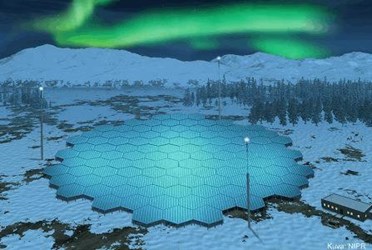UK To Build World's Most Advanced Space Weather Radar
By Jof Enriquez,
Follow me on Twitter @jofenriq

The government of the United Kingdom and international partners are starting to build in the Nordic region what will be the most advanced radar system for monitoring space weather.
Under construction starting next month in three sites (near Skibotn, Norway; Kiruna, Sweden; and Kaaresuvanto, Finland), the new £63m ($81.5 million) EISCAT_3D radar system will measure an entire 3D volume of the ionosphere to better understand how space weather works, as well as how to better protect satellites, communications, and power grids.
Solar wind and coronal mass ejections drive a stream of highly-charged particles toward Earth, which can fry satellite electronics or shut down power grids. The EISCAT_3D radar will collect unprecedented data, covering hundreds of kilometers, to give scientists a better understanding of how the Earth's magnetic field and near-space atmosphere interact with solar phenomena. Unlike conventional radars, beams from the new phased-array radar beams will 'look into' the transmitted beam and give researchers many intersection heights.
“The new EISCAT_3D radar will measure the ionosphere in lots of different directions simultaneously. It will be like having hundreds of dishes all operating together, looking in different directions,” said Dr. Andrew Kavanagh, UK EISCAT Science Support, based at the British Antarctic Survey. “This means we can easily see changes in the ionosphere [between 70 to 1000 km altitude] and don’t miss important data: when our measurements change we will be able to say whether something had just appeared or faded or if something was moving through the beams. This is really important as it gives us information about how space weather effects evolve.”
A better knowledge of the physics of this near-space region could result in better strategies to protect critical infrastructure.
Legacy EISCAT (European Incoherent Scatter Association) radars have been monitoring space weather using high-power ionospheric radars in the Arctic for over three decades. Building from this trove of data, and using both modern analog and digital technologies, the new EISCAT_3D radar will be capable of taking measurements “at least ten times faster and with ten times finer resolution than current systems,” according to the British Antarctic Survey.
In addition, “these systems will let us probe phenomena such as the aurora borealis in three dimensions and, in concert with a variety of other measurements, will allow us to uncover the fundamental effects of phenomena such as space weather.”
Both transmitter and receiver arrays will be built in the Skitbotn site. By contrast, only receiver arrays will be built in Kiruna and in Kaaresuvanto, according to AZO Sensors. Construction will begin in September 2017, with related site preparations scheduled in summer 2018. The radar system will be fully operational in 2021.
